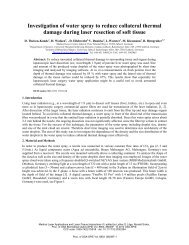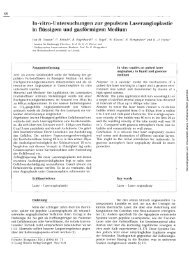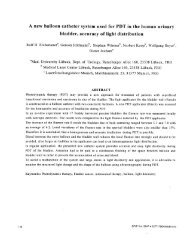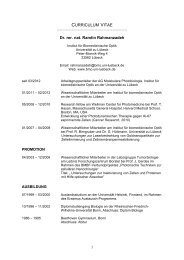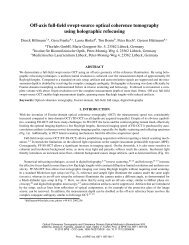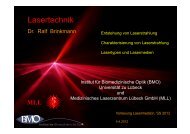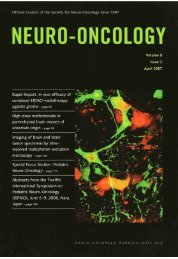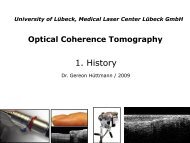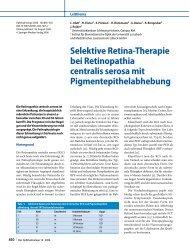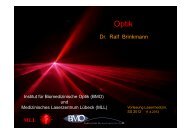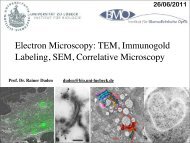Invited p aper Mechanisms of femtosecond laser nanosurgery of ...
Invited p aper Mechanisms of femtosecond laser nanosurgery of ...
Invited p aper Mechanisms of femtosecond laser nanosurgery of ...
Create successful ePaper yourself
Turn your PDF publications into a flip-book with our unique Google optimized e-Paper software.
VOGEL et al. <strong>Mechanisms</strong> <strong>of</strong> <strong>femtosecond</strong> <strong>laser</strong> <strong>nanosurgery</strong> <strong>of</strong> cells and tissues 1043strong temperature rise, the thermoelastic tensile stress leadsto bubble formation, and the <strong>laser</strong>-induced effects becomemore disruptive. The threshold for bubble formation definesthe experimental breakdown criterion for aqueous media.In our investigations performed for a numerical <strong>aper</strong>ture <strong>of</strong>NA = 1.3, it corresponds to a temperature rise <strong>of</strong> 131.5 ◦ Cand an end temperature <strong>of</strong> 151.5 ◦ C, well below the superheatthreshold. It was reached with a free-electron density <strong>of</strong>ϱ c = 0.236 × 10 21 cm −3 , which is below the threshold criterion<strong>of</strong> ϱ cr = 10 21 cm −3 commonly used in the modeling <strong>of</strong>plasma formation.Although it is convenient to distinguish between chemical,thermal, and thermomechanical effects, a clear separation betweenthese regimes does not exist for <strong>femtosecond</strong> <strong>laser</strong> effects.Because free-electron generation precedes any thermalor thermomechanical effects, the latter are never independent<strong>of</strong> free-electron-induced chemistry or multiphoton-inducedphotochemical effects. Temperatures that would usually leadto thermal denaturation are associated with millions <strong>of</strong> freeelectrons in the focal volume that produce chemical changes.The stress confinement <strong>of</strong> the energy deposition in <strong>femtosecond</strong>-<strong>laser</strong>-inducedmaterial processing is responsible forthe generation <strong>of</strong> large compressive and tensile stress amplitudesat a moderate temperature rise. Therefore, a temperaturerise <strong>of</strong> as little as 131.5 ◦ C is sufficient for bubble generationin a liquid without any pre-existing nuclei. The lowvolumetric energy density required for thermoelastically inducedcavity formation (only about 1/5 <strong>of</strong> the vaporizationenthalpy) is a reason for the lack <strong>of</strong> thermal side effects in<strong>femtosecond</strong> <strong>laser</strong> dissection and the small conversion rate<strong>of</strong> <strong>laser</strong> energy into mechanical energy. Moreover, it explainswhy at the bubble-formation threshold the bubble size ismuch smaller than for ‘conventional’ phase transitions withoutstress confinement.Based on the analysis <strong>of</strong> the <strong>laser</strong>-induced chemical andphysical effects, we investigated the working mechanisms <strong>of</strong><strong>femtosecond</strong> <strong>laser</strong> nanoprocessing in biomaterials with oscillatorpulses <strong>of</strong> 80-MHz repetition rate and with amplifiedpulses <strong>of</strong> 1-kHz repetition rate and revealed that they belongto two different regimes. Dissection at 80-MHz repetitionrate is performed in the low-density plasma regime at subnanojouleenergies well below the optical breakdown thresholdand less than one order <strong>of</strong> magnitude higher than thoseused for nonlinear imaging. It is mediated by free-electroninducedchemical decomposition (bond breaking) in conjunctionwith multiphoton-induced chemistry, and hardly relatedto heating or thermoelastic stresses. Dissection with 1-kHzrepetition rate is performed using about 10-fold larger pulseenergies (a few nanojoules) and relies on thermoelasticallyinduced formation <strong>of</strong> minute transient cavities that is probablyfacilitated by the free-electron-induced decomposition <strong>of</strong>biomolecules and by direct photochemistry.Unwanted side effects in <strong>femtosecond</strong> <strong>laser</strong> surgery areusually related to the formation <strong>of</strong> long-lasting bubbles in thehigh-repetition-rate mode that are produced by accumulativeheating and tissue dissociation into volatile fragments, andto excessively large transient bubbles in the low-repetitionratemode. Future experiments must explore the specific hazards<strong>of</strong> each side effect and define the respective ‘therapeuticrange’ for each surgical modality.The use <strong>of</strong> oscillator pulse trains is technically simpler and<strong>of</strong>fers the possibility <strong>of</strong> combining nonlinear material modificationwith nonlinear imaging. Amplified pulses allow us notonly to perform <strong>nanosurgery</strong> but are also suited for tasks requiringlarger cutting rates and pulse energies, such as the precisedissection <strong>of</strong> individual cells from histological specimensand their subsequent separation by <strong>laser</strong> catapulting, or thenon-destructive isolation <strong>of</strong> single cultured cells [225–227].They are probably also more suitable for high-throughput celltransfection.Short wavelengths seem to be especially well suited forthe manipulation <strong>of</strong> cellular events because the dependence<strong>of</strong> the free-electron density on irradiance is weak and thetuning range between chemical, thermal, and mechanical effectsis thus broader than for longer wavelengths. Short wavelengthsin the visible or UVA portion <strong>of</strong> the optical spectrumprovide, furthermore, better spatial resolution than infraredwavelengths. However, if simultaneous nonlinear materialmodification and nonlinear imaging is desired, one needs touse IR wavelengths because they have a larger optical penetrationdepth and enable us to produce multiphoton-inducedfluorescence, second-harmonic generation, or third-harmonicgeneration within a well-detectable wavelength range. Thelargest safety margin for nonlinear imaging without deleteriousside effects for the specimen exists when the differencein the order <strong>of</strong> the multiphoton effects used for imaging andionization is as large as possible, which is the case for IRwavelengths > 1000 nm.The principal mechanisms <strong>of</strong> <strong>femtosecond</strong> <strong>laser</strong> interactionwith biomaterials described above are not only relevantfor <strong>nanosurgery</strong> with tightly focused <strong>laser</strong> pulses butalso for applications such as intrastromal corneal refractivesurgery [11–14] or presbyopia treatment [228], where the<strong>laser</strong> pulses are focused at smaller numerical <strong>aper</strong>tures. In thelatter cases, nonlinear beam propagation must be taken intoaccount, and one needs to bear in mind that the thermoelastictensile stress amplitude produced by energy deposition intocylindrical volumes differs from those arising from sphericalor ellipsoidal volumes [155]. Similar considerations also applyfor the analysis <strong>of</strong> intraocular lesions from ultra-short <strong>laser</strong>pulses in the context <strong>of</strong> <strong>laser</strong> safety [183, 229, 230].Besides nanoprocessing <strong>of</strong> biological materials, lowdensityplasmas can also be used to modify other transparentmaterials and enable, for example, the generation <strong>of</strong> opticalwaveguides, couplers, or even <strong>laser</strong>s in bulk glass and fusedsilica [5–8]. The process <strong>of</strong> plasma formation in the bulk <strong>of</strong>other dielectrics like fused silica and glass strongly resemblesthe process in water [5, 116, 123, 231]. Variations aremainly due to differences in the band-gap energy, which is6.5eVfor water but ≈ 4eVfor barium aluminum borosilicate(BBS) and 9.0eVfor fused silica [123, 232]. The material responseto plasma formation will, <strong>of</strong> course, be modified bythe different threshold values for chemically and thermomechanicallyinduced changes. However, the methods employedin this p<strong>aper</strong> for the analysis <strong>of</strong> <strong>femtosecond</strong> <strong>laser</strong> effects inwater can also be used to study the effects created in soliddielectrics. When pulse series with high repetition rate areused, low-density plasmas may lead to the formation <strong>of</strong> defectsor color centers that are associated with a change <strong>of</strong>the refractive index [233, 234]. Thermal effects produced



